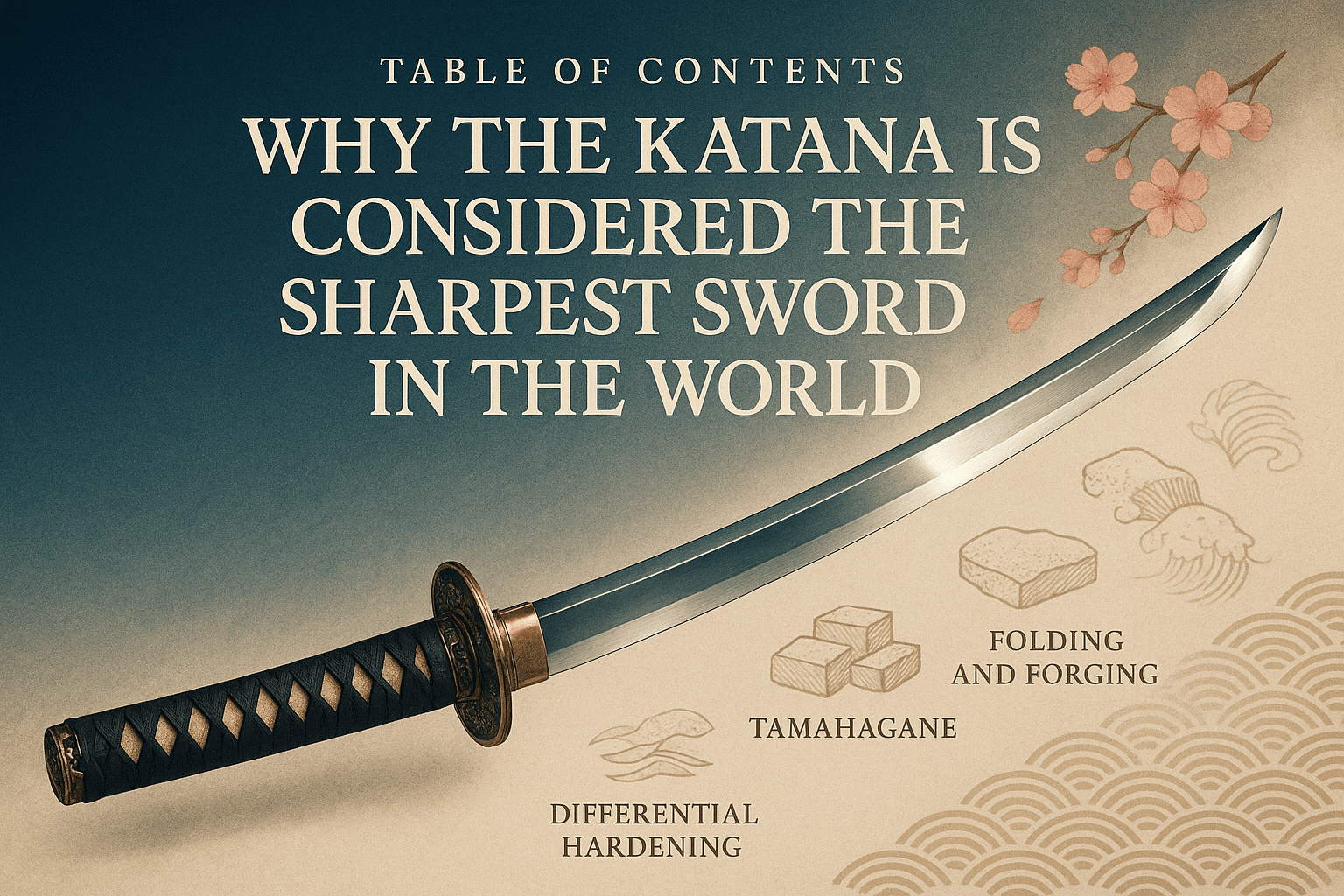Introduction: The Blade that Endures
Few weapons in history capture the imagination like the katana. Forged through centuries of craftsmanship and carried by legendary samurai, the katana is more than just a sword—it’s a symbol of precision, discipline, and deadly elegance. Its reputation extends far beyond Japan’s shores, celebrated worldwide for its extraordinary sharpness and cutting power. Blending art and engineering, the katana represents the pinnacle of blade-making tradition, earning its place as perhaps the sharpest sword ever created. This article explores the secrets behind the katana’s revered edge—and why it continues to fascinate warriors, collectors, and historians alike.
What “Sharp” Truly Means
When people talk about a sword being “sharp,” they often imagine an edge so keen it can slice through silk mid-air. But sharpness in sword-making is more complex than just cutting ability. At its core, sharpness is a combination of blade geometry, material composition, and the sword’s intended use.
A truly sharp blade features a fine, precise edge angle—often created by tapering the blade to a narrow point. The katana excels here with its asymmetric cross-section and differential hardening process, producing a harder edge (typically around 60 HRC on the Rockwell scale) for razor-sharpness, while maintaining a softer spine for flexibility. This allows the blade to hold an extraordinarily fine edge without becoming brittle—a balance many other blades struggle to achieve.
But sharpness isn’t just about slicing paper or cutting vertically through bamboo in martial arts demonstrations. A sword’s purpose influences how sharp it needs to be. European longswords, for instance, were often designed for both cutting and thrusting through armor—so their edges were durable but not necessarily razor-fine. The katana, by contrast, was primarily intended for precise, sweeping cuts against lightly armored or unarmored opponents, so its design emphasized a sharper, more refined edge that could glide effortlessly through flesh and bone.
Ultimately, sharpness is a synergy of craftsmanship—where geometry, metallurgy, and purpose align. And in that alignment, the katana stands out not just for how sharp its edge is, but for how well its entire design supports and sustains that sharpness.
Tamahagane: The Soul of the Katana
Forged from fire and tradition, tamahagane—meaning “jewel steel”—is the heart of a true katana. This distinctive Japanese steel is created through a centuries-old smelting process in a clay furnace called a tatara. Over several days, master smiths layer charcoal and iron sand (satetsu) in precise amounts, maintaining high heat and airflow to refine the metal. The result is a dense, carbon-enriched steel that possesses a unique balance of hardness and flexibility.
What sets tamahagane apart is its carbon variability. Bladesmiths separate and select pieces with varying carbon concentrations to serve different parts of the blade: higher-carbon sections provide razor-sharp edges, while lower-carbon regions create a core that can bend without breaking. Through repeated folding and hammering, impurities are removed, and the grain structure is refined, enhancing both strength and aesthetic beauty.
The meticulous crafting of tamahagane ensures that the katana isn’t just sharp—it holds its edge with incredible resilience. This steel gives the blade a soul, allowing it to slice with precision while enduring the rigors of real combat. Without tamahagane, the katana would lack the legendary performance that makes it the sharpest sword in history.
Folding and Forging: Discipline in Every Layer
The katana’s legendary sharpness is born from a process as poetic as it is precise: folding and forging. This craft begins with tamahagane, a high-carbon steel derived from iron sand, rich in impurities. To purge these imperfections, master swordsmiths repeatedly heat, hammer, and fold the metal—sometimes dozens of times. With each fold, impurities are gradually worked out, while layers of steel accumulate, aligning the grain structure for greater strength and uniformity.
But folding does more than just cleanse—it aligns the carbon content across the blade, creating alternating layers of hard and soft steel. This sophisticated layering enables the katana to possess a razor-sharp edge capable of slicing with surgical precision, while maintaining a resilient spine that absorbs shock without shattering. It’s a delicate balance honed over centuries, blending metallurgical mastery with unwavering discipline. Every layer tells a story—not just of steel, but of relentless refinement in pursuit of peerless sharpness.
The Art of the Edge: Differential Hardening
One of the key secrets behind the katana’s legendary sharpness lies in an ancient technique known as differential hardening—a process that perfectly balances power and grace in the steel. Japanese swordsmiths mastered this art by applying a special clay mixture to the blade before it was heated and quenched. The edge, left mostly exposed or with a thinner layer of clay, cools rapidly to become incredibly hard, while the spine, heavily coated in clay, cools more slowly and remains softer and more flexible.
This method creates a blade with contrasting steel structures: martensite at the edge, which is hard and capable of taking a razor-sharp edge, and pearlite at the spine, which offers resilience and shock absorption. The result is a sword that can slice through targets with breathtaking precision while resisting cracks and breaks during heavy use.
The signature wave-like hamon line visible on finished blades is more than just ornamental—it’s the visible testament to the artistry of differential hardening. This fusion of functional engineering and aesthetic expression is a hallmark of the katana and a major factor in why it’s revered not just as a weapon, but as a masterpiece of metallurgical innovation.
Precision over Haste: Sharpening the Katana
Sharpening a katana is a meticulous art form, not a race. Unlike Western sharpening techniques that often prioritize speed, the Japanese method, known as togi, emphasizes patience and precision. A skilled togishi (polisher) may spend weeks on a single blade, using an array of progressively finer whetstones—some made from rare natural materials sourced only from Japan. Each stroke refines not just the edge but the soul of the sword, revealing the hamon—the wavy temper line that is as functional as it is beautiful.
The edge is honed with microscopic exactitude, achieving a keenness that seamlessly balances slicing power with edge retention. This isn’t just about making a blade sharp—it’s about crafting a cutting edge capable of slicing through bamboo, silk, or even bone with minimal resistance. Every motion is deliberate, every angle intentional, preserving the katana’s geometry and enhancing its lethal elegance.
In this process lies the secret to the katana’s legendary sharpness: relentless attention to detail and a reverence for the blade. It’s not the haste of steel against stone that defines the katana, but the deliberate artistry of sharpening—a tradition elevated to a ritual, creating an edge like no other.
In Action: The Katana’s Cutting Power
Throughout history, the katana’s reputation as a razor-sharp weapon hasn’t just been born of legend—it’s been proven time and again through dramatic demonstrations of its cutting power.
In feudal Japan, samurai and smiths alike tested a blade’s quality through tameshigiri, the practice of trial cutting. Blades were judged not just on aesthetics but on their ability to slice cleanly through rolled tatami mats, bamboo stalks, and even armor or cadavers—a grisly but standardized way to evaluate cutting performance. Records from the Edo period include engravings on the tangs of katanas noting how many bodies a single stroke had severed, a testament to both the smith’s and the sword’s prowess.
Fast forward to modern-day martial arts dojos, and tameshigiri lives on as a disciplined art that showcases the katana’s unmatched sharpness and precision. Trained practitioners use authentic blades to slice through multiple rolled mats in a single, fluid motion, mimicking the density of human limbs. These demonstrations not only require a sharp sword but impeccable technique—yet it’s the katana’s design, with its curved edge and meticulous forging, that makes such cuts possible.
Contemporary test videos further confirm the sword’s cutting supremacy. Footage of expert users cleanly slicing through dense targets like ballistic gel torsos, steel pipes, and tree trunks illustrates just how formidable the katana remains, even beside modern blades. The combination of steel quality, differential hardening, and the geometry of the edge results in a cutting tool that’s still regarded as the gold standard for sharpness and lethality.
Whether in ancient battlefield tests or today’s high-speed camera captures, the katana consistently lives up to its legendary edge.
Conclusion: Why Sharpness Is Not Just a Trait
The katana’s sharpness is more than just a physical attribute—it’s a reflection of centuries of discipline, balance, and intentional design. Forged through meticulous craftsmanship and guided by philosophical ideals, the blade represents harmony between form and function. Its ability to cut with precision isn’t merely a testament to steel and technique, but to a mindset that honors purpose over power. In the world of swords, the katana stands apart not only because of its legendary edge but because of what that edge symbolizes: a pursuit of mastery that goes beyond the surface, cutting straight to the essence of art and warrior spirit.





